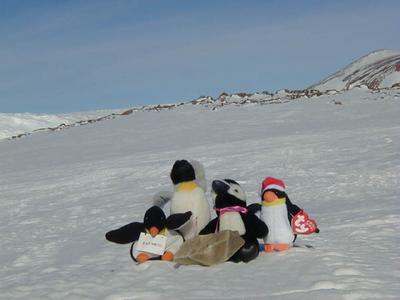30 December, 2002
A Change of Season
Antarctica is great for lulling one into a sense of complacency. Last
night, after we returned, the winds died down and the temperature rose. It
was a very pleasant night until the winds picked back up around 6:00
AM. Instead of going back to the "Lower lip of the Mouthy Ice," as Dante
calls it, we decided we would be warmer doing some moraine searching.
We headed back to Harvaine Moraine and finished it off within a couple of
hours. We only found two meteorites, but now we've collected over 360 this
season. We started to search That Moraine, when Jamie sped off on his
Ski-Doo to talk to Nancy. The conditions had worsened to the point that
the temperature was just above 0F and the wind was gusting up to 15
knots. That gave us a windchill about -33F. The wind rushing through my
parka was so loud that I had a hard time hearing if anyone needed help
collecting. At that point we decided to call it a day.
Despite today's weather, we've actually been pretty lucky. We are getting
further into the Antarctic summer and it's interesting to see the changes
that take place in both the natural environment and in the operations of
the US Antarctic Program.
The greatest change is happening at McMurdo. They are having some bad
weather today, but overall their temperatures are rising and the sea ice
that surrounds Ross Island in thinning. McMurdo sits right on the boundary
between the annual sea ice and the permanent ice of the Ross Ice Shelf. In
some warmer years, the sea ice melts all the way back to McMurdo. The ice
is now too thin to maintain the ice runway that we came in on and left
from. All the buildings have been moved and the operations and flights now
take place out of Willie Field. This is also an ice runway, but it is
located on the permanent ice a few miles from McMurdo on the other side of
Scott Base. When we return, we will land on Willie Field and leave from
there for New Zealand.
Most of the LC-130 flights out of McMurdo are fuel flights to the
pole. About 50 people including support staff and scientists winter over
at the South Pole Station and cannot receive any resupply during the
Antarctic winter. Therefore, it's necessary to stock them up with plenty
of fuel to keep them warm during the long, dark winter. This is good for
us because we are camped below the flight path of the LC-130s returning
from the pole. When it's time for our pull-out, they will probably have
one of those planes stop and pick us up.
The thinning ice at McMurdo makes it possible for an icebreaker to come
in. This icebreaker not only brings supplies, but also takes out all the
trash produced by the US Antarctic Program. The icebreaker creates leads in
the ice along which Minke and Orca whales often follow finding fresh
nutrients. Orcas often come close to McMurdo looking for penguins and new
seal pups. This is the time of year that Weddell seals wean their pups and
start pushing them into the water. "Just when you thought it was safe to
go into the water..."
One of the questions I was asked most often before I left was whether I
would see any penguins. I feel fortunate to have seen the one on my
excursion to Cape Evans. But I've found a major misconception about
Antarctica is that this wildlife lives all over the continent. The coast
is the only place that wildlife can live because there is almost no liquid
water in the interior and the conditions are too harsh. It's a little
strange sometimes knowing that there are no plants or animals around
here. I half expect to hear birds in the morning, like when I'm camping
back home. Or, I expect squirrels to pick up any chips or peanuts that I
drop at lunch. But those food scraps will remain forever if I don't pick
them up. I was also asked frequently before I left if I was worried about
polar bears. I am not. The closest wild polar bear lives about 14,000
miles away near the North Pole.
Although the last couple of days have been a little blustery, I'm
optimistic that the weather will warm again.

A rare sighting of penguins at MacAlpine Hills.
Contact the TEA in the field at
.
If you cannot connect through your browser, copy the
TEA's e-mail address in the "To:" line of
your favorite e-mail package.
|
